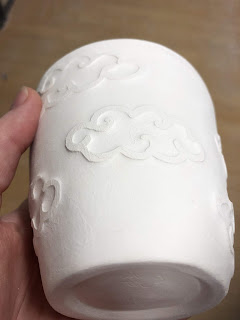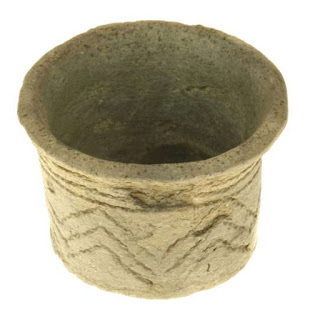I moved out of Leederville over a year ago and I was quite sad to no longer interact with the Willy Wag Tail I'd tamed while she was hatching her eggs on my porch. Happily, the new house has a WWT who is even more tame and demanding. He followed me into my basement to demand mealyworms from me even though he'd already had two snacks that day. Isn't he cute?
Wednesday, 29 April 2020
Tuesday, 28 April 2020
Green but not like the others
I thought I'd try something a little different. I love the extant article, the way the light shines through the carved design is simply beautiful. I have tried to capture the design for the green-black series but it's not quite as effective.
This is the cup post glazing. The small crack in the rim has been sealed with the glaze. I double dipped this one in the transparent green glaze and you can see it's had quite a runny effect. While it doesn't do my underglazing any favours, the transparent green running off the sea green has created the most delightful sparkles on the inner rim. There's also a pool of transparent green in the center of this cup which is beautiful. Not what I wanted but some nice colour play all the same.
I plan on attempting this design again at least twice more. Once I'll carve to allow the glaze to pool and thicken in areas. The other I'll practice hydro-abrasion on and have more prominent areas raising up out of the glaze. It'll be interesting to see which is the most effective with this glaze combination.
Sunday, 26 April 2020
2 level hydro-abrasion
I got impatient while waiting for the previous attempt at hydro-abrasion to be fired. So I started on the next project. The aim of this one is to create some depth in the design by applying the shellac, removing the clay, then repeating.
Step 1: design. I used a medallion motif from a broken plate. I don’t like the central design on the plate but I thought the medallions were charming. The leaves are a common motif of the time.
1200s, Seljuk. Iran or Syria. Cleveland Art Museum 1915.590.
This is the design after the first layer of shellac. I love the golden tone!
I used a scalpel to trim away unwanted shellac before abraiding. It is really important to angle the blade away from the shellac so it isn’t under cut. I found some of the thicker areas tore if I wasn’t careful. This is probably because this isn’t a new knife blade and may be a little dull.
This is the cup after the second layer has been applied and a raised. As you can see, I shadowed the outer loop with a second layer and added a small arrow leaf in the middle / top. For comparison the two medallions on the bottom haven’t been a raised yet.
With 8 design elements to raise, I found was really important to stop and let the cup dry after every 2-3 items. Otherwise the rim was absorbing a lot of the water and getting squishy.
This dark blue glaze was very thick and it took forever to dry. As you can see it's reasonably runny so it pools nicely in little pockets. I do need to be aware of it along the foot though as it threatens to spill over and cement my piece to the kiln shelf. I'm really happy with how this came out even though I wanted the second, lower level to hold more glaze.
Friday, 24 April 2020
Basic hydro-abrasion
Recently I encountered a fellow potter at Claymake. She had the most lovely relief patterns on a cup. When I inquired how she'd achieved such fine lines she told me she was experimenting with shellac resist then removing the clay body with water. She couldn't tell me much more about the process so I decided to google it. I couldn't find any videos on Youtube but there are a number of ceramic boards which make some interesting reading. One board suggested using shellac as a resist as it's a naturally derived product that will burn off in the bisque firing. The following is my initial experiment and thoughts.
The only brand and smallest bottle of shellac available in the store. It would have been cheaper to purchase shellac flakes and make my own but there were no solvents available so I couldn't.
A slightly skewed cup. I picked it up when it was too damp and it tilted. Still usable and if not for this experiment it wouldn't have been fired.
Step 1:
Use a paintbrush to apply shellac to dry greenware. The greenware will adsorb all of the alcohol and the shellac will dry really fast. If you want finer lines, leave a small amount of shellac out in the sun to thicken for half an hour or so.
Thoughts - the shellac applies well but when it is the thickness of water you either need to only have a small amount on your brush and keep dipping and wiping or use a thicker consistency. If you don't, drips of shellac will spread making thicker lines and blotches. I like the golden shine and can see why this is used on furniture.
It occurs to me that stencils could be used with technique if the shellac were slightly thicker.
Step 2:
Use a wet sponge to wipe away clay from around your design. This is called hydro-abrasion even though typically that term is applied when using pressurized water. Circular motion of the sponge seems to prevent one side of the line from getting too much lower than the other. When the clay turns to a slurry, use the other, sopping, side of your sponge to wipe the clay away. Work on one area then move to another.
I used a brand new dish sponge. Under the sponge is a bit I've already done, the other three clouds still need attention. It's reasonably easy but I did get clay water everywhere.
Thoughts - This may work better as a staged step. I found that the water had undermined the strength of the cup. As I posed and held the cup my thumb has created a small divot in one side while between my fingers a small crack has formed. I think I managed to fix both but I believe that I need to reduce the amount of free water and probably do one side, wait for it to dry then do the other side. In the image above you can see a small area on the bottom cloud where I've accidentally wiped away the shellac. I believe this was because it was rather thin in that area. The thicker shellac, the more golden areas, seems to have held up fine.
Step 3:
Thoughts - It came out well. I'm really happy with how the relief works. I think it'll show off a glaze nicely. I also think this could be a substitute to create once off tiles patterned off molded items.
Step 4:
Glaze & stoneware fire it. I chose midnight blue glaze with a clear overcoat.
Thoughts - Love this look. Next time I'll use a thicker cup and try a two layer design. I think this may work really well for some heraldic displays similar to those carved in marble. I may also try a colour resist. After the first wash, I'll place some englobe or underglaze on the cup and then apply a second coat of Shellac.
#not-so-pro tip: hydro-abrasion works best if the sponge is run parallel to design. Right angles creates more of a sloped edge and it is harder to achieve a clear difference in clay body level.
#not-so-pro tip: hydro-abrasion works best if the sponge is run parallel to design. Right angles creates more of a sloped edge and it is harder to achieve a clear difference in clay body level.
Labels:
AandS,
Bisque,
Cup,
Experimental,
Handthrown,
hydro-abrasion,
Not-so-pro tip
Saturday, 18 April 2020
Green globe cup attempt 4
13-14th century, Syria. The Met Museum. Accession 56.185.8
I thought this design would translate nicely.
The bisque was underglazed in black using two brush sizes and a thin squeeze bottle. That variation of line thickness really helps this design. This will be dipped in an opaque midgreen then overglazed in a deeper translucent green. I'm really happy with how this design came out. There are some minor errors but nothing that detracts from the design.
Monday, 13 April 2020
Non-medieval hydro-abrasion fun
Front
Back
Not everything needs to be medieval. I thought these designs would provide a nice balance between thin and thick glaze. I suspect the lobes will work better than the vines with a simple overglaze dip so I’m going to use a sponge to clean up the vines and see what happens.
Lobe cup. I quite like this one but I think next time I’ll have some elements coming up from the base of cup as well.
Sunday, 12 April 2020
Glaze pallets
I made some glaze pallets so I could see how well the various colours worked on stoneware and the difference between the local buff clay and pb103. I’ve done this in the past, creating two test tiles with and without a titanium white base glaze.
It was important to make some new tiles because I’ve purchased some new colours and I needed to see what the impact of multiple layers was. These will be critical to making the colour choices for an upcoming collaboration.
Left- PB103, right - buff. Each divot is top third 1 layer, middle 2 and base 3 layers. The top 20 colours are the Chrysanthos glazes. The bottom glazes are five selections from the Glazeit pallet which I suspect are Duncan underglaze. Black is Cesco ebony brush on underglaze.
It was important to make some new tiles because I’ve purchased some new colours and I needed to see what the impact of multiple layers was. These will be critical to making the colour choices for an upcoming collaboration.
Left- PB103, right - buff. Each divot is top third 1 layer, middle 2 and base 3 layers. The top 20 colours are the Chrysanthos glazes. The bottom glazes are five selections from the Glazeit pallet which I suspect are Duncan underglaze. Black is Cesco ebony brush on underglaze.
Thursday, 9 April 2020
Practices makes perfect
I found a lovely cup on a viking related blog (Bjornthisway) and thought it was the perfect thing to aim for to continue developing my skills. This cup resides in the Sydvstjyske Museum in Ribe. The main features of this item are straight sides with even walls, a lip and probably, a tight square internal corner.
I'm getting there.
Saturday, 4 April 2020
Kashan fish cup
I don’t really care how the overglaze on this one turns out. I’m already very happy with how this design has turned out.
I copied this design from the bowl above. I’ve found two images of it but other details are slim. It is captioned ‘ Bowl with fish (late 13th to mid-14th century), Iran, probably Kashan. Stonepaste; black decoration under transparent turquoise glaze. The Hossein Afshar Collection’. I’ve found a similar bowl at the Art Gallery of South Australia here but it doesn’t have quite the same fishy swirl.
This is going to look amazing once it is green!
Subscribe to:
Comments (Atom)




























